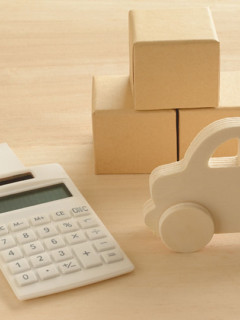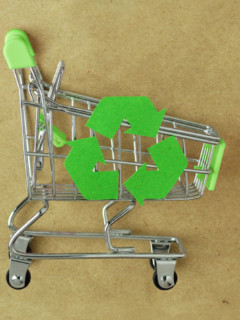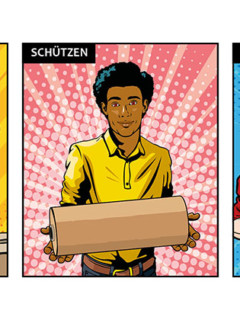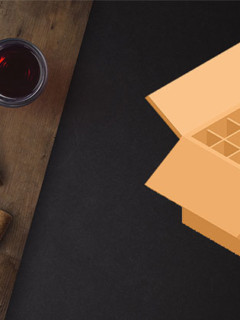The thoughtless use of (disposable) plastic has long been passé. In almost every company, at every retailer, shipper, logistics company and manufacturer, all processes are examined and questioned: Where can material be saved, where can less environmentally friendly material be replaced? Logistics without plastic – there is potential along the entire production chain, i.e. in purchasing, production, storage, transport and shipping. Especially in packaging, a lot can naturally be achieved.
The absolute “match winner” is paper. Wherever possible, plastic is replaced by the more sustainable material. Logistics without plastic: This raises two questions:
Is paper in fact and per se more environmentally friendly to use than plastic? And:
What are the limits of fibre, simply because of paper’s inherent properties?

One thing is clear: the production of paper also places a heavy burden on the environment. Even the renewable resource wood is not infinite. The water needed to produce paper is an increasingly valuable resource and so is the energy needed to make paper. The negative impact at least on wood consumption can be reduced many times over by recycling paper and using recycled paper for the production of (packaging) material.
New processes in the production of paper also make the “new paper”, made from virgin fibres, more resource-efficient. And there is also movement as far as recycling processes are concerned: According to a study by the Graz University of Technology, 2021 has dispelled the common opinion that cardboard can only be recycled 4-7 times before the fibre properties no longer permit further use. In the test series, folding cartons were recycled several times and the changes in the material were examined with regard to strength and pressure resistance. The result: the mechanical properties and the swelling capacity were not negatively affected even after being recycled up to 25 times.
An exciting result, because: “The more often the same packaging can be recycled, the more positive its effects on the environment are”, according to the study./p>
Paper replaces stretch film and strapping tape
In the field of packaging, but also for storage and transport, RAJA has always offered good alternatives made of paper or (corrugated) cardboard. Paper bags for sorting, storing and portioning, but also for shipping (paper shipping bags), paper pads for cushioning and fixing in the box, paper document bags, paper tapes, bin liners and even pallets made of corrugated cardboard have long been established in our range. New, however, are stretch paper as an alternative to stretch film, paper strapping and bubble paper as an alternative to bubble wrap. For whom are these innovations interesting? What are the advantages but also the disadvantages of paper for use in storage, transport and even export? For this it is important to understand: What are the properties of paper?
Material properties of paper
Excursus: “Fresh” paper is made from fibrous material (also pulp). This pulp is usually obtained from wood by means of a wood pulping process (mechanical and chemical). Pulp consists mainly of cellulose and also contains lignin. If the paper is made from fresh fibres, i.e. directly from wood, this means that the fibres have not yet been subjected to a recycling cycle.
Cellulose obtained from virgin fibres and cellulose obtained from recycled paper: does that make a difference? How do the properties of paper made from virgin fibres differ from those of recycled paper? What changes as the percentage of recycled paper increases?
Fibre properties of paper or: What exactly are the properties of paper?
Paper can be so different… There are big differences in general properties, geometrical properties, physical properties, mechanical properties and optical properties. When comparing the properties of paper or cardboard on the one hand (paper from a thickness of 250g/m² up to a thickness of 500 g/m² is called cardboard) and plastic on the other hand as a packaging material, some are quite crucial:

Hygroscopy
Hygroscopy, the extent to which the material attracts and binds water:
Paper is highly hygroscopic, the fibres absorb and release moisture. If the fibres are enriched with moisture (one also says: they swell), this changes the physical properties of the material: paper curls, it expands, the edges warp. Damp paper tears more easily, wet paper can become a real “mess”. But ambient air that is too dry also has an effect on paper: if it gives off too much moisture, paper is electrically charged, it shrinks, becomes brittle and fragile.
Many plastics are also hygroscopic, to a lesser extent. But not PE and PP: both are non-hygroscopic plastics. This means that water from the ambient air does not enter the material, but is deposited on the surface instead. Fluctuating air humidity therefore has little or no influence on the stability and tear resistance of plastic.
The mass per unit area
The mass per unit area or also the weight:
Depending on the mass per unit area, one speaks of paper, cardboard or paperboard. DIN 6730 specifies: Up to 220g weight per square metre it is paper. If the weight per square metre is over 225g/m², it is cardboard, and if the weight is between 150-600 g/m², it is cardboard. Cardboard (Why is corrugated cardboard so stable?) is incredibly stable. A three-wall corrugated cardboard folding box, for example, can carry payloads of up to 350 kg, with a tare weight of less than 5 kilograms.
Weight can certainly play a role in packaging. But film also has a very low dead weight. If you compare a film mailing bag with a paper mailing bag, for example, the differences are, literally, hardly noticeable. Even in terms of cushioning material, bubble wrap is not superior to bubble wrap in terms of weight.
The tensile strength
The tensile strength, i.e. how much tensile force causes the material to tear:
Here the facts speak for the film. The tensile strength of a film is usually given by the manufacturer as a percentage. The folded bag 50 μ RAJA, made of LDPE and with a film thickness of 50 µ can, depending on the size, be overstretched by approx. 400 % in length before it tears. In width even significantly more! That is enormous. Such stretchability is not found in paper. But paper bags are also extremely resilient, depending on the paper quality and thickness. Their tensile strength or tear resistance is given in kilograms. The 2-wall, stable paper bag with a grammage of 180g per square metre has a tear strength of 65kg.
- Direct comparison? Difficult. For plastic bags, the value is usually in %, for paper bags in kilograms.
Another problem: in combination with wetness, paper loses much of its stability. The cellulose fibres become saturated with water (see hygroscopy), and the hydrogen bonds (see Fig.: (The chemical structure of cellulose) that hold the fibres together loosen. If the material then dries again, the volume of the paper remains larger because of this – and the material itself is much more susceptible to cracking.
Specific tear resistance
The tear resistance, also known as notch strength, is also measured in Newton (n). It indicates how little or how much force is required to tear a material further – if it is already torn or cut.
(Ageing) resistance:
Film or plastic is considered more durable. If your intention is to signal long-term, leak-proof and weather-resistant protection, i.e. if your message is to be: Here is something for “eternity”, then plastic is the right choice. On the other “side of the coin”, of course, is that plastic, precisely because of this resistance, decomposes only very slowly and not completely. Plastic is considered biologically “inert”, which means that it virtually does not mineralise. Although the plastic particles become smaller and smaller (keyword: microplastic), they are never completely degraded. Instead, the microplastic particles accumulate e.g. on beaches and seas.
Paper, on the other hand, decomposes. It is only considered resistant to ageing under certain conditions, measured and evaluated in so-called life expectancy classes (LDK). The highest LDK according to DIN 6738) is LDK 24-85, which guarantees age resistance; a service life of at least several hundred years is also guaranteed by the LDK below it, LDK 12-80.
A paper mailing bag will degrade in about 6 weeks, whereas a mailing bag made of film will not degrade for more than 100 years. With the Tyvek® mailing bag you get a product that has the look and feel of paper, but the properties of film or even a little more: Tyvek®, a special plastic fleece, is a 100% synthetic material, light and breathable like paper, but absolutely water-repellent and extremely tear- and tensile-resistant. It is not naturally degradable – but when disposed of properly, it is still environmentally friendly: since it consists largely of polyethylene and contains no plasticisers, only water and carbon dioxide are produced when it burns, but no toxic gases. Even better: the material can be recycled up to 5 times more often than other plastics.

Symbolic effect
Generally speaking and generalised: paper is considered more sustainable. So if you also want to set a sign for sustainability and responsibility to the outside world (customers, partners) and it is important to you that you are perceived as a responsible market participant, you can score points here by using paper in sometimes perhaps unexpected areas of packaging.
Where paper can replace plastic in transport, shipping and logistics – and where it can’t (yet):
These questions are important when considering the use of paper in warehousing, shipping and logistics. After all, switching to paper should of course not result in any losses in terms of protection, resilience, stability or durability – in short: no reduction in quality.
Therefore, in this article we will introduce you to some of our products made of (recycled) paper and tell you their areas of application – under which circumstances they beat their “product colleagues made of plastic” or for which purposes we rather do not recommend them.
Stretch film vs. stretch paper
In warehousing, shipping and transport, goods are stretched for various purposes. The “classic”: The goods are ready on the pallet and are to be stabilised for further transport or storage. It is therefore a matter of bundling individual parts such as cartons or other containers, pipes or canisters and fixing them stably on the pallet. Whether you use stretch film or stretch paper depends on these points:
| Stretch paper | Stretch film | |
|---|---|---|
| Shape of the load | Homogeneous, i.e. uniform in shape and size | Homogeneous, but also heterogeneous, i.e. corners, edges and possibly peaks stand out |
| Use | Internal storage or dispatch and transport (in the case of direct transport, e.g. in the company’s own truck from loading bay to loading bay) | Dispatch and transport (in case of direct transport, e.g. in the company’s own truck from loading ramp to loading ramp, there is nothing to be said against paper!) |
| Expected storage or shipping time | Short-term: The pallet is often unpacked in company A after a few days, sometimes even after a few hours, in company B and the packaging that is no longer needed is: rubbish. For such short-term transports, stretch paper is ideal – unless the load is very heterogeneous, see above, or is exposed to high humidity. | |
| Opaqueness desired? | Paper is opaque | Stretch film is translucent and opaque. But there is also coloured stretch film that is opaque. |
Paper strapping – PP Strapping RAJA
Similar aspects as when deciding whether stretch paper can be a suitable alternative to stretch film apply to the use of paper strapping. The product, new in RAJA’s range, is absolutely interesting for sealing and bundling for products that are stored indoors. With all the typical advantages of paper! Again, under certain conditions, the supposed “disadvantages” of paper, such as its susceptibility to moisture, are of no consequence. It is, when storing light products indoors, an absolutely competitive alternative. We compare:
| Paper strapping | PP Strapping RAJA | |
|---|---|---|
| Suitable for machine use | yes | yes |
| Hand tearable | yes +++ | no |
| Risk of injury | close to zero +++ | given |
| Resistance | short term storage, indoor | High +++ |
| Tensile strength/ tensile strength | up to 55 kg | up to 204 kg +++ |
| Special features | Environmentally friendly appearance +++ Soft to the product, recyclable degradable |
Weather resistant, recyclable |
Document pouches made of paper RAJA – Document pouches Eco transparent RAJA
In the decisive product properties, the paper document pouches are on a par – under expected weather conditions (i.e. when the parcel or package is not exposed to heavy rain), the paper document pouches also keep the documents safe. However, paper comes out on top again when it comes to disposal and in terms of feel and appearance. We compare:
| Document Pockets Paper | Document Pockets Eco | |
|---|---|---|
| Material | 100% recycled paper: parchment paper coated with kraft paper | Made of PE 60µand silicone paper |
| Disposal | Problem-free with the cardboard in the waste paper, as it is mono-material | can only be recycled if it is disposed of separately from the cardboard |
| Transparency | yes +++ | yes |
| Self-adhesive | yes | yes |
| Weather resistant | to a small extent | yes |
| Special features | Environmentally friendly look +++ |
Paper packing tapes RAJA – PP packing tape RAJA
Even superior to PP packaging tape in terms of handling and appearance: The paper packing tape is extremely easy to handle, can even be torn by hand if necessary, and can be disposed of absolutely sorted with the cardboard in the waste paper. The comparison:
| Paper packing tapes RAJA | PP packing tape RAJA | |
|---|---|---|
| Load capacity | For light to medium-weight packages up to approx. 25 kg | For medium-weight cardboard boxes up to approx. 25 kg in standard quality, For heavy cardboard boxes up to approx. 30 kg in industrial quality |
| Hand tearable | yes | no |
| Temperature resistance | Short-term up to 65 °C Cold resistant up to -15 °C |
Short-term up to +65 °C Cold resistant up to -17 °C |
| Disposal | Problem-free with the cardboard in the waste paper, as it is mono-material | can only be recycled if it is disposed of separately from the cardboard |
| Special features | Environmentally friendly appearance +++ |
Padding material or void fill (by hand)
There is a lot of controversy here in particular. In our blog “Padding, filling, protecting: Safe transport and shipping” we present the various options for proper cushioning. In addition, we explain how proper padding works and why solid padding protection is important and ultimately even a contribution to environmental protection. We have made a brief comparison of two of our “classics” in the field of upholstery protection:
| Crinkle paper in dispenser box | FloPak Standard | |
|---|---|---|
| Made from | 100% recycled paper | 100% recycled polystyrene |
| Yield | One box corresponds to the volume of 3 bags of filling material of 0.5 m³ each | Bag content: 0.5 m³ |
| Material advantages | Certified: Blue Angel,
Lightweight, space-saving storage |
Antistatic, insensitive to water, dust-free, lightweight |
| Padding protection | Sufficient, suitable for “usual” shipping, ideal cavity filling | Special 8-shape guarantees good cushion protection and stability |
| Special features | Padding properties “suffer” with moisture | High space requirement for storage and processing |
You will find the complete selection of filling and upholstery materials in our webshop. If you are unsure which filling material is suitable for you, please contact us – we will be happy to advise you! In the blog you will find valuable tips around the clock on possible areas of application, e.g. also on the question: When are upholstery machines worthwhile?
By the way: In the field of paper cushioning machines, we will soon be offering you another really good alternative to void fill: With the FillPak ® Trident paper cushioning system, you will be able to produce 100% paper-based cushioning protection. The highlight: Thanks to the patented, special shape, which has excellent cushioning properties, even 15% less material is needed “by the way”. The FillPak ® Trident is therefore also particularly economical and resource-saving when it comes to efficient cavity filling!














